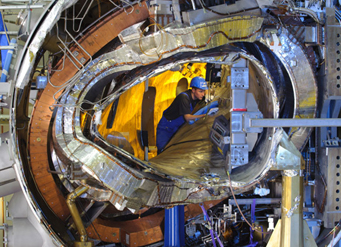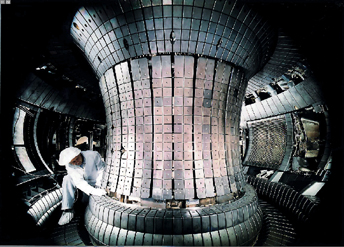
| 
|

|
| Like
something out of a scrap press: this is what the torus of the Wendelstein
7-X “stellarator,” completed in 2014, looks like. In this device,
plasma is held in suspension by magnetic fields. The squashed shape
is the result of sophisticated calculations designed to create a particularly
stable and heat-insulating magnetic cage.
|
Beautifully
symmetrical: The competing “Tokamak” principle has a simpler design.
However, a major disadvantage compared to the “Stellarator” is the
instability of the plasma, which only allows for pulsed operation.
The photo shows the ASDEX Upgrade, which has been operated by the
Max Planck Institute for Plasma Physics in Garching since 1991.
|
| |
Photos (2): IPP |
German government plans to fund fusion research with over two billion euros
On October 1, the German government adopted an “action plan” to
provide greater support for fusion research than before. Under the title
“Germany on the way to a fusion power plant” (PDF), it announced that
it would provide a total of more than two billion euros for this purpose
by 2028. In doing so, it wants to push ahead with the commissioning of
the “world's first fusion reactor in Germany”, as was somewhat
prematurely declared a goal of the government in the coalition agreement
between the CDU/CSU and SPD, which must step down again by the
beginning of 2029 at the latest (250403). In any case, the realization
of nuclear fusion that can be used for power generation is not expected
worldwide before the middle of the century, as the German Academy of
Engineering Sciences has stated (241206). For this reason alone, nuclear
fusion will not be able to contribute to the achievement of the climate
targets set for that time (PDF).
From the outset, the “world's first fusion reactor in Germany” was primarily a political compromise
From the outset, this point in the coalition agreement was less a
realistic goal than a political compromise: it allowed the Union parties
to save face by committing to relatively “clean” electricity generation
via nuclear fusion, which is still a long way from becoming a reality,
and thus to stick to the “nuclear energy option” in a striking manner (250801). In return, the Union parties had to back down from their
previous demands for an extension or even a revival of conventional
nuclear energy. Otherwise, the SPD would not have been prepared to form a
coalition government. The coalition agreement therefore makes no
mention of nuclear power plants based on nuclear fission, all of which
have now been decommissioned.
Level of funding to date increases approximately threefold
The electricity generation from nuclear fusion heat provided for in the
coalition agreement will therefore not be available for at least the
next two decades. Even after the end of the current government, it will
take at least three to four legislative periods before fusion power
plants become technically feasible and could gain practical
significance. This puts pressure on the CDU/CSU and SPD to at least give
the impression that things could move faster by increasing funding for
relevant research. The more than two billion euros that they now want to
make available over the four-year legislative period corresponds to
over 500 million euros per year and more than three times the previous
funding, which was last estimated by the Federal Ministry of Research at
approximately 150 million euros.
After all, it is by no means the case that research into nuclear fusion
has been recklessly neglected up to now. The “action plan” now adopted
by the black-red federal government even ties in directly with a very
similar project presented by the SPD, Green Party, and FDP coalition
government in March 2024 under the title “Fusion 2040 Funding Program –
Research on the Way to a Fusion Power Plant” (PDF). The only thing that
has changed is the amount of money that the fusion industry lobby can
expect to receive in the future.
The main beneficiaries are four companies, each of which wants to bring about nuclear fusion in different ways
The beneficiaries of the increased cash flow are four companies or lobby
groups, each of which is trying to tackle the still unresolved
technical problems of nuclear fusion in different ways. Despite decades
of effort and a whole host of experimental facilities worldwide, there
is still not a single research reactor that can consistently generate
more energy than it consumes. These four companies were all established
between 2019 and 2023 and are listed in the Bundestag's lobby register.
They are not only active in Germany, but also cooperate internationally,
primarily with partners in the US. At the same time, however, they have
little equity capital and virtually no income from ongoing business,
which is why they are as dependent on subsidies from the state, their
shareholders, or other patrons as fish are on water.
Gauss Fusion GmbH
This company was founded in June 2022 by private industrial companies
from Germany, France, Italy, and Spain and collaborates with leading
research institutions. These include CERN, the Max Planck Institute for
Plasma Physics (IPP), the Karlsruhe Institute of Technology (KIT), ENEA,
and Eindhoven University of Technology. The company name was apparently
derived from the older unit of measurement for magnetic flux density,
which has since been replaced by “Tesla.” The incorrect spelling ‘Gauss’
instead of “Gauß” is not due to the new spelling rules, but was
probably chosen out of consideration for the international partners.
According to the commercial register, the company has equity capital of
€2 million, which is far more than its three competitors. On October 9,
Gauss Fusion GmbH presented a cost and time schedule for a first
commercial fusion power plant called GIGA, estimating the cost of this
project at €15 to €18 billion.
Proxima Fusion GmbH
This company was also initiated by employees of the Max Planck Institute
for Plasma Physics and entered in the commercial register in Munich in
March 2023. Unlike Gauss Fusion GmbH, however, it does not intend to
further develop the “Tokamak,” but wants to develop a functional fusion
reactor based on the “Stellarator.” It has since increased its share
capital from an initial €20,000 to €63,218. As it announced on October
9, it has also raised a total of €200 million for the development of a
commercial fusion power plant by 2030, which will use “QI-HTS
stellarators” to provide sufficient heat for power generation. A team of
scientists and engineers from leading companies and institutions such
as the IPP, MIT, Harvard, SpaceX, Tesla, and McLaren is working on this
goal and has now grown to around 100 employees.
Marvel Fusion GmbH
This company was founded in July 2019 and is also based in Munich. It
takes a unique approach by using boron protons instead of
deuterium-tritium as fuel, with fusion being initiated by high-intensity
lasers. It is a consortium of scientists from Ludwig Maximilian
University of Munich (LMU), Extreme Light Infrastructure for Nuclear
Physics (ELI-NP), Stanford University, and the Massachusetts Institute
of Technology (MIT) who want to work together to realize this fusion
concept. Marvel Fusion GmbH can draw on over €385 million in funding
from public and private investors. A cooperation agreement between the
company and Ludwig Maximilian University is supported by the state of
Bavaria with €2.5 million. According to the commercial register, the
company's equity capital amounts to €132,780.
Focused Energy GmbH
Focused Energy GmbH was entered in the commercial register in Darmstadt
in August 2021. To date, only €25,000 has been reported as equity
capital. The company's second headquarters is in Redwood City,
California. It is a technology spin-off from the University of Darmstadt
that cooperates with the US company National Energetics (Texas). Like
Marvel Fusion, Focused Energy pursues the concept of laser-controlled
fusion, but uses the more conventional deuterium-tritium approach of the
National Ignition Facility (NIF). The company received financial
support from, among others, the German Federal Agency for Disruptive
Innovation, which awarded it the SPRIN-D prize worth $50 million.
According to its latest self-description, “the world's leading laser
fusion company employs around 100 of the best minds from relevant
research institutes and universities in Europe and the US.”
Proxima, Marvel, and Focused Energy demanded “at least €3 billion by 2029”
A week before the announced cabinet decision on the “action plan” to
promote nuclear fusion, three of these four companies - Proxima, Marvel,
and Focused Energy - published an appeal to the federal government
demanding “state start-up financing of at least €3 billion by 2029” for
their business. Only in this way could they “mobilize private capital on
a large scale and pave the way for the first fusion power plant in
Germany.”
Gauss Fusion GmbH estimated the cost of its project at €15 to €18 billion
Gauss Fusion GmbH did not participate in this appeal. Instead, a week
after the cabinet decision, it presented its draft for the development
of a fusion power plant, which it said could be realized by the
mid-2040s and would cost €15 to €18 billion. This sum would indeed be
GIGA, as the promising name of the project is to be called. And since
the price level of 2025 was used as a basis, it is likely to increase
significantly by the mid-2040s due to inflation.
The output of the planned GIGA fusion power plant was not specified.
However, it is likely to be in the usual range of conventional nuclear
power plants, which cost significantly less. Even the financially
derailed Olkiluoto 3 nuclear power plant in Finland was 4 to 7 billion
euros cheaper, despite costing almost three times as much as originally
planned.
The first fusion power plant would be overwhelmingly uneconomical
Even without cost overruns, conventional nuclear power plants are
already far too expensive to compete with electricity from renewable
energies. France's EDF, for example, has revised the construction costs
for further EPR-type nuclear power plants upward to at least €8.4
billion after the originally estimated €3.4 billion for the first
domestic EPR in Flamanville exploded to over €19 billion. Since the
construction costs for the GIGA fusion power plant are estimated to be
twice as high, this would result in overwhelming unprofitability for
power plants powered by heat from nuclear fusion.
Links (internal)
- How nuclear fusion made it into the coalition agreement (250801)
- With “nuclear energy light,” the CDU is accommodating both the SPD and the CSU (250403)
- The CDU does not want to give up on the “nuclear power option” (250202)
- Nuclear fusion will not be able to make a significant contribution to
the electricity supply until after 2045 at the earliest (241206)
Links (external, without guarantee)
- PDF ESYS publication series “Kurz erklärt!” (Briefly explained!): Is nuclear fusion an energy source of the future? (21 pages)
- PDF Scientific Services of the German Bundestag: Nuclear fusion – financing and forecasts (18 pages)
- PDF BMFTR action plan: Germany on the way to a fusion power plant (12 pages)
- PDF Fusion 2040 funding program – research on the way to a fusion power plant (49 pages)

